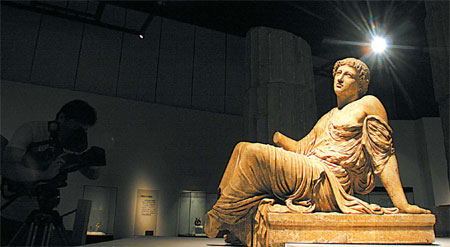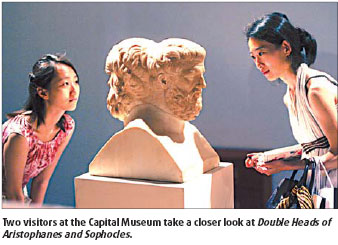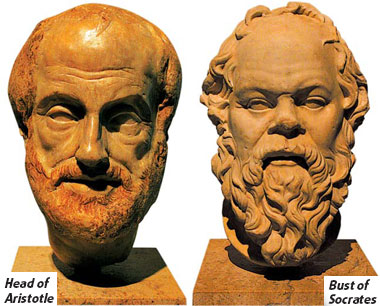Romancing the stone
 |
|
Statue of Woman in Sitting Posture Photos by Jiang Dong |
Thirty years later, the statue was given to Louis XIV who placed the sculpture at the north entrance of the Hall of Mirrors in the Palace of Versailles. A century later, it was seized during the French Revolution and has been at the Louvre until recently when it set off for another journey, to China.
Through November 9, some 130 precious pieces from the Department of Greek, Etruscan and Roman Antiquities of the Louvre will be on exhibition at the Capital Museum, the first time that works from the museum are seen in Beijing.
Guo Xiaoling, curator of the Capital Museum, says visitors and museum officials feel lucky to have such an opportunity.

The Department of Greek, Etruscan and Roman Antiquities of the Louvre is now under renovation, Guo says, which makes it possible for other museums to borrow the pieces.
The showpieces chosen for the maiden Beijing show, including stone, gold, bronze and terracotta works, feature the artworks from the 4th and 5th centuries, the golden age of Greek literature, art and politics.
Many museums were trying to borrow the artworks but three Asian museums succeeded. After the show in Beijing, the exhibits will be enjoyed by art lovers in Singapore and by people in the Macao Special Administrative Region.
Soon after viewers walk into the exhibition hall, a magic journey begins. A replica of the Parthenon's ruins, featuring reddish columns and round platforms, matches the show's theme - Greek treasures.
The piece at the entrance is Athlete Holding Discus made during the 1st and 2nd centuries. The statue seems peaceful at first glance, but a careful observation of the hunched deltoid and the crooked toes reveal that the man is summoning his power.
Representing a regular part of ancient Greek games, the statue unveils the exhibition's first part: Live in Classical Age.

The section also features appliances of the Greeks' everyday life, such as flagons, masks, earrings and bracelets, and even a bronze brush for bathing.
Gods are eternal themes among classical Greek art pieces. There are at least three statues of Aphrodite on exhibition. In addition to the one of Arles, the Head of Aphrodite is another brilliant piece.
The marble piece is the best among imitations of the great Greek sculptor Praxiteles' original work which has long been lost.
The copy brings Praxiteles' unique style into life by a combination of a slim neck and face, small mouth, the hair which shapes the forehead as a triangle, the two parallel hair laces, and the deep lower eyelid. It has established the classic model of Greek beauty which has been a huge influence on Western art.
Among the exhibits in this section is a mysterious sculpture named Statue of Woman in Sitting Posture. Archeologists have not identified her so far.
With one foot bare and another in a shoe, the woman supports herself with a hand while the other stretches ahead. Most people with only one shoe in Greek myths are said to have miserable fates, such as Dido, Queen of Carthage, who threw away one of her shoes before she killed herself in a fire.
Some guess the woman is Danaeu. Zeus changed himself into golden rain to seduce her and made her pregnant. Others think she may be Io, who was transformed into a cow by Zeus to protect her from the jealous Hera, or Callisto, who was changed into a bear by Zeus for the same reason.
The speculations are largely based on the statue's pose, which looks like she is trying to ask for help before being transformed.
Some of the most eye-catching pieces, however, are human beings. In the third section: Dialogue with Celebrities, viewers are surrounded by Greek philosophers and artists, extraordinarily wise people even if judged by the modern standards.
The thinkers' works, introduced to China as part of a series in the 1980s, have led to a huge stir among Chinese intellectuals. The works of Plato and Aristotle are still an important course in most university's philosophy department.
Guo says he thought of placing the books beside the statues to remind people of the masters' influence on China. It was a pity they had not enough time to practice the idea at last.
Highlights include a bust of Socrates. According to literature by Plato and Xenophon, his two students, the philosopher has a long beard, a bald forehead, a small and closely placed eye, and a big and flat nose. Another student, Alcibiades, even described him as a kind of grass. The unpleasant description of his apprentices, as some say, is to reveal a philosophical idea that beauty is not judged by appearance.
But now viewers don't have to guess by the various descriptions what the philosopher looks like. His marble eyes are gazing at every visitor in the hall. Apparently, Plato and Xenophon are closer to the truth. Together with him are the bust of Plato, one of his favorite students, and head of Aristotle, another great thinker of the time.
Some of the most remarkable Greek artists, such as Aristophanes and Sophoclean, all have their places in the section.
For the ancient Greek men and gods - if they were endowed with life - the Beijing exhibition would be a unique journey; it should be the same for those who spend some time with these glorious pieces.
(China Daily 08/15/2007 page18)














